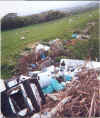On Monday the 22nd of November 1999, The Draft Waste Management Plan for Kerry, was presented to the members of Kerry county council. On the 27th of October 1999, Sliabh Luachra C.E.S. presented the Kerry County Council with a Illegal Dump Survey, done in the Sliabh Luachra area. Up to today we have not had any further reaction from the council. To our knowledge no big dump side's have been cleaned up. By contacting the council about our local illegal dumps, we can keep the pressure up. The survey shows information on: Location, grid, reference, accessibility, size, contents, impact level and visibility.
|
|||||||
|
About 80 severe illegal dumpsites were discovered in the Sliabh Luachra area. The general public opinion seems to be one of disgust. Most of these dumps are directly on the roadside, in full view, often in streams. Again most of the dumps contain dangerous items, like batteries and car parts, washing machines, containers of all sorts, in some cases carcasses. These contents mixed with household waste and farm wastes are good conditions for rats to live and breed. This dangerous environment with the health risk involved, exist right next to living areas. Numerous Newspaper articles in Local press in 1999 show the enormous concern among the public about the present state of affairs. The dumpsite Survey conducted by Castleisland C.E. Scheme, Rural Development Office in 1999 in the Sliabh Luachra area of Kerry shows an extensive problem exists.
|
|||||||
|
Proposed Solutions:
campaign of information to deter recurrence. It could be designated as a Millennium Project. The local people in my opinion cannot undertake a clean up of the countryside, as this would be a dangerous job. The fact that most of the dumps are directly on the roadside makes it too dangerous with the traffic. The second problem would be the health hazard, as the contents of most of these dumps are dangerous to handle.
Madelon greve
Litter and local Government Fund!? A programme of measures to tackle the country's litter problem. The Litter Pollution Act, 1997, provides local authorities with the powers necessary to tackle litter and requires a new and more structured approach to litter management planning. Increased funding is available to local authorities to fight the litter problem from the significant increase in funding for day to day expenditure available to them in 1999 under the Local Government Fund. Among the measures now being taken are the ∑ establishment of an ongoing monitoring regime to assist and review local authority enforcement action and help to identify and eliminate litter black-spots; ∑ co-funding of selected local authority public education and awareness initiatives in black-spot areas; ∑ promotion of anti-litter awareness among young people, in co-operation with the Department of Education and Science and through a new schools information programme developed by ENFO; ∑ provision of financial support for An Taisce's project: National Spring Clean 1999 - a multi-sectoral initiative to raise public awareness and participation in anti-litter initiatives at local level, which includes a central role for local authorities. contact:
colm_keenan@environ.irlgov.ie
|
 click
here to see big click
here to see big
Most of these dumps are directly on the roadside, in full view, often in streams. Again most of the dumps contain dangerous items, like batteries and car parts, washing machines, containers of all sorts, in some cases carcasses. These contents mixed with household waste and farm wastes are good conditions for rats to live and breed.
|